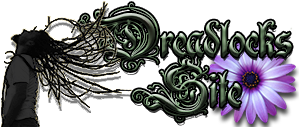AfricansBlack Africans and people of Black African descent are known to wear this hairstyle. Various African tribes wear locks and the styles change from one group to another. The warriors of The Maasai tribesmen of Kenya are famous for their long, thin, red dreadlocks. These men dye their hair red with root extracts. In West Africa what are known as Fetish priests, spiritual men or women who serve and speak to spirits or deities, often wear locks. In Benin the priests of the Yoruba religion of Olokun the spirit of water wear locks. The Hemba people in the southeast of Congo-Kinshasa also dye their dreadlocks red, but their style is thicker than that of the Maasai. Other tribes include the Fang people of Gabon, the Mende of Sierra Leone, and the Turkana people of Kenya.Africans brought the hairstyle with them to the Americas during the African diaspora. As a result of this the style can still be seen on people of African descent from North America, South America and the Caribbean. Well-known Black artists such as Bob Marley, George Clinton, Rosalind Cash, Whoopi Goldberg, Alice Walker, Eddy Grant, Toni Morrison, Lauryn Hill, Lenny Kravitz, Bobby McFerrin, Tracy Chapman, Terrance Hobbs and Mike Smith of death metal band Suffocation, Malcolm Jamal Warner, Living Colour, Lil Wayne and Keith Hamilton Cobb wear (or have worn) the hairstyle. Even though it is not always political, some black people wear dreadlocks as a symbol of black pride and cultural identity. For some women, its a way to break free both from western standards of beauty and from chemically straightening their hair.RastafariThe Rastafarians wear locks as an expression of inner spirituality and to emphasize their identity. Their religion states that they must remain "whole" (hence why Rastafarian Bob Marley refused to have a cancerous toe removed which could have saved his life). Following Haile Selassie, cutting dreads is highly prohibited in the Rasta culture. Due to this, dreads knot naturally because their hair is not to be tampered with.Another interpretation among the Rastafari is that "dread" refers to the fear that dreadlocked Mau Mau warriors inspired among the colonial British.[citation needed] The Mau Mau, a largely ethnic Kikuyu rebel group in Kenya fighting to overthrow their colonial British oppressors from 19521960, hid for many years in the forests, during which time their hair grew into long locks. The images of their rebellion, then broadcast around the world, are said to have inspired Jamaican Rastafari to wear locks.[9]Dreadlocks on a Rasta's head are symbolic of the Lion of Judah which is sometimes centered on the Ethiopian Flag. Rastas hold that Selassie is a direct descendant or reincarnated form of Christ. Rasta's also believe African people are the descendants of the Israelites' Tribe of Judah through the lineage of Kings of Israel David and Solomon, and that he is also the Lion of Judah mentioned in the Book of Revelation.HinduismSimilarly, among some Sadhus and Sadhvis, Indian holy men and women, locks are sacred, considered to be a religious practice and an expression of their disregard for profane vanity, as well as a symbol of their spiritual understanding that physical appearances are unimportant. The public symbol of matted hair is re-created each time an individual goes through these unique experiences.[citation needed] In almost all myths about Shiva and his flowing locks, there is a continual interplay of extreme asceticism and virile potency, which link the elements of destruction and creation, whereas the full head of matted hair symbolizes the control of power.[citation needed]Gangadhara Shiva captures and controls the river Ganges with his locks, whose descent from the heavens would have deluged the world. The river is released through the locks of his hair, which prevents the river from destroying earth. As the Lord of Dance, Nataraja, Shiva performs the tandava, which is the dance in which the universe is created, maintained, and resolved. Shiva's long, matted tresses, usually piled up in a kind of pyramid, loosen during the dance and crash into the heavenly bodies, knocking them off course or destroying them utterly.Sadhu with jata (long locks) twisted in a knot on top of the head.Locks in India are reserved nearly exclusively for holy people. According to the 'Hymn of the longhaired sage' in the ancient Vedas, long jatas express a spiritual significance which implies the wearer has special relations with spirits, is an immortal traveller between two worlds and the master over fire:

The long-haired one endures fire, the long-haired one endures poison, the long-haired one endures both worlds. The long-haired one is said to gaze full on heaven, the long-haired one is said to be that light ... Of us, you mortals, only our bodies do you behold. ...For him has the Lord of life churned and pounded the unbendable, when the long-haired one, in Rudras company, drank from the poison cup (The Keshin Hymn, Rig-veda 10.136)The Shaiva Nagas, ascetics of India, wear their jata (long hair) in a twisted knot or bundle on top of the head and let them down only for special occasions and rituals. The strands are then rubbed with ashes and cowdung, considered both sacred and purifying, then scented and adorned with flowers.Western StylesWhen reggae music gained popularity and mainstream acceptance in the 1970s, the locks (often called dreads) became a notable fashion statement; they were worn by prominent authors, actors, athletes and rappers, and were even portrayed as part and parcel of gang culture in such movies as Marked for Death.Dreadlocks have moderate popularity in western heavy metal culture. Pictured is Chris Barnes, the vocalist of the death metal band Six Feet Under.With the Rasta style in vogue, the fashion and beauty industries capitalized on the trend. A completely new line of hair care products and services in salons catered to a white clientele, offering all sorts of "dreadhead" hair care items such as wax (considered unnecessary and even harmful by some)[citation needed], shampoo, and jewelry. Hairstylists created a wide variety of modified locks, including multi-colored synthetic lock hair extensions and "dread perms", where chemicals are used to treat the hair.Locked models appeared at fashion shows, and Rasta clothing with a Jamaican-style reggae look were sold. Even exclusive fashion brands like Christian Dior created whole Rasta-inspired collections worn by models with a variety of lock hairstyles.In the west, dreadlocks have gained particular popularity among certain subcultures. Examples of these are the New Age Traveller, hippie, crust punk, hyphy and gothic subcultures. Also it has gained popularity as a style among youth of both Black African and European descent. Members of the cybergoth sub-culture often wear blatantly artificial "dreadfalls" made of synthetic hair, fabric or plastic tubing.source wikipedia http://en.wikipedia.org/wiki/Dreadlocks that sorta paints the west as being totaly devoid of spiritualityi would like to add my own ramblings on the westernized spirituality of dreadlocks that are not superficial fashion based or idol worshipthe western dread culture is avery wide variety of beliefsfrom earth based religions and native culture spirituality (like native american) to rastafarian to pagan cristian jew and wican buddhist or muslimvirtualy every religion and soirituality has some dreadiness in its roots (no pun intended)often you might even find a blending of beliefswith a return to a more natural existence at the corethere is a strong urge in the face of modern industrilization and strict government control to return to a more natural existence living more in harmony with nature and being more free, at least feeling in some way government control is not totaleven for those who cannot take it all the way, loving off the grid in harmony with nature and as much as possible outside the grasp of government control, at least adopting a natural hairstyle lets them feel more connecterd to the earth and less controlled by the strict expectations of societyso you may thinkj this sounds more like rebelion then spiritualitybut the rebelion can be very much a spiritual rebelion.a deep love for the earth for living harmoniously many give up meat (without having to believe its religiously right to) they preffer natural products and ofteen become more conceinstios of how they treat others.often therrs a profound spiritual connection to the dreads themselves. often they are spoken of as antenaes to higher reasonings or roots that ground them to the earth and connect them to all things.some dreasds take peices of other cultures like tthe aversion to vanityor the avoidance of alcaholin western culture the connection of dreads to religion and spirituality is more indivuidual and often very deep.at times this goes above and beyond the expectations of theyre individual religions. like in christianity and judeism the vow of the naserine often is ignored and concidered obsolete but a member of that religion may choose to honour that vow and grow out long dreadlocks for lifethe western culture and its connection to rekligios or spiritual dreading is far more difficult to define because its such a blend of beliefs that there could easily be 10,000 definitions
--
My new book Ban The Taboo Vol 1
updated by @soaring-eagle: 02/14/15 03:18:36AM



 Jelly said:
Jelly said:  care to share your reason for having dreadlocks. I think that one deserves a topic of its own.
care to share your reason for having dreadlocks. I think that one deserves a topic of its own.